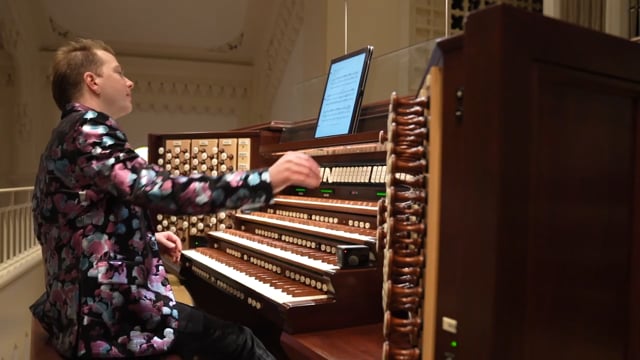
Létourneau Pipe Organs, Saint-Hyacinthe, Québec, Canada, has completed a new organ for Brigham Young University, Provo, Utah.
The firm’s Opus 100 comprises 82 stops; 81 ranks; 4,608 pipes across four manuals and pedal.
Discussions began in 2019 between BYU and Létourneau Pipe Organs about a new pipe organ for their forthcoming concert hall. The design was largely complete at that time, and the hall today is the core of BYU’s new music building.
Behind and above the stage is the organ chamber, within which now resides Létourneau’s Opus 100. Its 45-foot-wide wooden façade was made from rift-sawn oak and walnut with vertical maple accents. Nestled into the casework are 93 speaking tin pipes taken from the bass octaves of the Great 16′ Double Open Diapason, the Great 8′ First Open Diapason, the Pedal 16′ First Open Diapason, and the Pedal 8′ Principal stops.
The university’s organists, Don Cook and Neil Harmon, expressed a desire for an instrument in English Town Hall style.
The tonal plan for Opus 100 follows an established recipe: The organ features two distinct open diapasons on the Great, as well as open diapasons in the Swell and Choir divisions. The Great principal chorus is based on a 16′ Double Open Diapason with multiple mixtures to suit the desired effect; the Great is completed by a battery of trumpets on eight inches of wind. The Swell duplicates the Great in many ways but on a smaller scale, while the instrument’s more delicate effects are found in the Choir. The Solo division offers a powerful wooden flute stop, a briny pair of narrow-scale violes d’orchestre, and two orchestrally inspired reed stops. Brawny might be a good adjective for the Pedal division, with its two 32′ flue stops, a 16′-8′ Open Wood rank, and a compelling reed chorus from 32′ through 4′.
For information: www.letourneauorgans.com/
University website: http://cfac.byu.edu/organ
Inaugural season of events: organ.byu.edu/concert-hall-series/
Cover photo: Nate Edwards / BYU Photo
Létourneau Opus 100 is featured on the cover of the December 2024 issue of The Diapason:
https://www.thediapason.com/content/cover-feature-letourneau-opus-100
Other organ builder news:
Muller organ for Mount Vernon, Ohio







